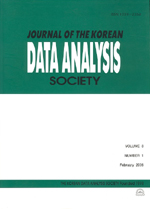기본 무특성 성분 및 각 성분 비율의 제한적 구간 존재 시의 혼합물 성분 비율 조합의 최적화
Optimizing the Component-Proportion Combination of a Mixture in the Presence of the Basic and Featureless Component and the Restrictive Intervals of Component Proportions
- 한국자료분석학회
- Journal of The Korean Data Analysis Society (JKDAS)
- Vol.15 No.6
-
2013.123133 - 3139 (7 pages)
- 7

본 연구는 혼합물 실험에서 기본 무(無)특성 성분과 각 성분 비율의 제한적 구간이 존재할 때 혼합물의 특성치를 최적화하는 성분비율 조합을 찾아내기 위한 방법을 제안한다. 일반적인 혼합물 실험 설계에는 특정 성분이 100%를 차지하거나 0%인 설계점들도 들어 있으므로, 우리의 상황에서는 보통의 혼합물 실험 설계를 사용할 수 없다. 본 논문에서 제안하는 방법에서는, 혼합물이 k개의 성분으로 이루어진다고 할 때, 기본적인 성분이지만 혼합물의 특성을 결정짓지 못하는 성분을 성분 k로 놓고, 이 성분을 제외한 나머지 성분의 각 구간 내 퍼센티지 값들을 요인 수준들로 하는 일반적인 (k-1)-요인 반응표면설계를 작성한 후에 성분 k의 퍼센티지는 100에서 나머지 성분들의 퍼센티지 값의 합을 뺀 것으로 하여 실험실시용 k-성분 설계를 완성하고, 이를 이용하여 실험을 실행한 후에 반응표면분석을 통하여 성분 1부터 성분 (k-1)까지의 최적 퍼센티지들을 찾아내고, 성분 k의 최적 퍼센티지 값은 100에서 성분 1부터 성분 (k-1)까지의 최적 퍼센티지들의 합을 뺀 값으로 정한다. 5-성분 혼합물 실험의 예시적 설계 및 분석을 통해 방법을 설명한다.
This article proposes how to search for the component-proportion combination that optimizes a characteristic of a mixture in the presence of the basic and featureless component and the restrictive intervals of component proportions. Ordinary mixture designs cannot be used in this situation because they contain the design points at which some component has a proportion of 1 or 0. Suppose that the mixture of interest consists of k components. The method proposed here starts with setting aside the basic and featureless component and calling it component k. Then, construct a response surface design in the coded levels of the proportions of components 1 through (k-1). In the experimental design in actual proportions, the proportion of component k is set to be 1 minus the sum of the other (k-1) proportions. Then, perform the experiment and analyze the experimental data to optimize the proportions of components 1 through (k-1). The optimum proportion of component k is set to be 1 minus the sum of the other (k-1) optimum proportions. This method is illustrated though the design and analysis of an experiment with a five-component mixture.
1. 서론
2. 예시를 통한 방법 설명
3. 결론
References
(0)
(0)